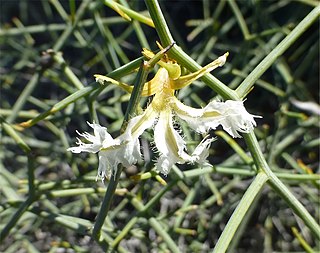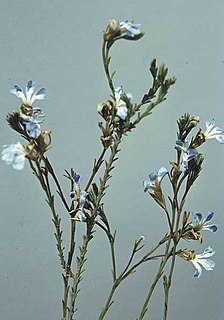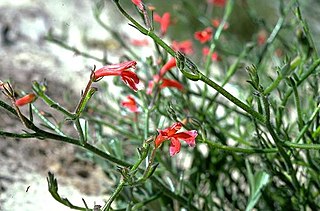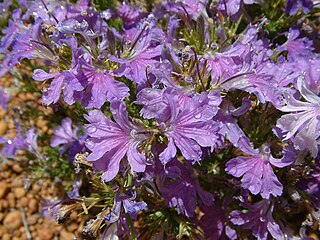
Lechenaultia biloba, commonly known as blue leschenaultia, is a species of flowering plant in the family Goodeniaceae and is endemic to the south-west of Western Australia. It is a glabrous herb or subshrub with spreading branches, almost no leaves, and yellow, tube-shaped flowers.

Lechenaultia linarioides, commonly named yellow leschenaultia, is a species of flowering plant in the family Goodeniaceae and is endemic to near-coastal areas in the west of Western Australia. It is a sprawling subshrub with many tangled branches, narrow, crowded, rather fleshy leaves, and yellow and deep pink to purplish red flowers.

Lechenaultia macrantha, commonly known as wreath leschenaultia, is a species of flowering plant in the family Goodeniaceae and is endemic to inland areas of south-western Western Australia. It is a low-lying, wreath-like herb or subshrub with narrow, rather fleshy leaves, and yellow petals with deep pink or red wings.

Lechenaultia formosa, commonly known as red leschenaultia, is a species of flowering plant in the family Goodeniaceae and is endemic to the south-west of Western Australia. It is a prostrate or erect shrub or subshrub with crowded, narrow, fleshy leaves and scarlet or orange-red to pale orange flowers.

Lechenaultia divaricata, commonly known as tangled leschenaultia, wirenetting bush or wirebush, is a species of flowering plant in the family Goodeniaceae and is endemic to arid and semi-arid areas of central Australia.

Lechenaultia tubiflora, commonly known as heath leschenaultia, is a species of flowering plant in the family Goodeniaceae and is endemic to the south-west of Western Australia. It is a hemispherical subshrub or more or less erect perennial with crowded, narrow, rigid leaves and variably-coloured, tube-shaped flowers.
Lechenaultia aphylla is a species of flowering plant in the family Goodeniaceae and is endemic to arid parts of inland Australia. It is a glabrous herb or subshrub with spreading branches, almost no leaves, and yellow, tube-shaped flowers.
Lechenaultia brevifolia is a species of flowering plant in the family Goodeniaceae and is endemic to inland south-western Western Australia. It is a tufted, sparsely-branched subshrub with crowded, narrow, fleshy leaves and white and blue, tube-shaped flowers.
Lechenaultia chlorantha, commonly known as Kalbarri leschenaultia, is a species of flowering plant in the family Goodeniaceae and is endemic to a restricted area near Kalbarri in Western Australia. It is a subshrub or shrub with many branches, crowded, narrow, fleshy leaves and pale bluish-green, tube-shaped flowers.

Lechenaultia floribunda, commonly known as free-flowering leschenaultia, is a species of flowering plant in the family Goodeniaceae and is endemic to the south-west of Western Australia. It is an openly-branched shrub or subshrub with crowded, narrow, fleshy leaves and compact groups of pale blue to pale mauve or creamy white flowers.
Lechenaultia galactites, commonly known as white leschenaultia, is a species of flowering plant in the family Goodeniaceae and is endemic to the south-west of Western Australia. It is an erect, robust subshrub or shrub with crowded, narrowly oblong to egg-shaped leaves, and white to pale blue flowers.

Lechenaultia heteromera, commonly known as claw leschenaultia, is a species of flowering plant in the family Goodeniaceae and is endemic to the south-west of Western Australia. It is a subshrub with a few wand-like branches, fleshy leaves, and white and pale blue flowers.

Lechenaultia hirsuta, commonly known as hairy leschenaultia, is a species of flowering plant in the family Goodeniaceae and is endemic to the west of Western Australia. It is a straggling, low-lying shrub with few branches, fleshy leaves, and scarlet flowers.

Lechenaultia juncea, commonly known as scarlet leschenaultia, is a species of flowering plant in the family Goodeniaceae and is endemic to the south-west of Western Australia. It is a open, ascending shrub with narrow, crowded, rather fleshy leaves, and scarlet to orange-red flowers.

Lechenaultia longiloba, commonly named Irwin leschenaultia, is a species of flowering plant in the family Goodeniaceae and is endemic to the south-west of Western Australia. It is a straggling, low-lying herb or subshrub with narrow, rather fleshy leaves, and pale yellow or green petals with deep pink or red wings.
Lechenaultia lutescens is a species of flowering plant in the family Goodeniaceae and is endemic to inland central Australia. It is a wand-shaped, ascending herb or subshrub with rigid, narrow leaves, and orange-yellow to pale yellow or creamy-white flowers.

Lechenaultia magnifica, commonly known as magnificent leschenaultia, is a species of flowering plant in the family Goodeniaceae and is endemic to the south-west of Western Australia. It is an erect, perennial herb or subshrub with crowded, linear to narrowly lance-shaped leaves, and pink to mauve or purple flowers.
Lechenaultia papillata is a species of flowering plant in the family Goodeniaceae and is endemic to inland areas of south-western Western Australia. It is a diffuse, ascending shrub or subshrub with papillate, crowded, slightly fleshy leaves, and pale blue flowers.

Lechenaultia pulvinaris, commonly known as cushion leschenaultia, is a species of flowering plant in the family Goodeniaceae and is endemic to inland areas of south-western Western Australia. It is a low-lying, hemispherical shrub with narrow, rigid, crowded, hairy leaves, and pale blue or purple flowers.
Lechenaultia striata is a species of flowering plant in the family Goodeniaceae and is endemic to arid inland areas of Australia. It is an ascending herb or subshrub with only a few wand-like branches, crowded, narrow fleshy leaves and pale blue to pale yellow or creamy-white flowers.












